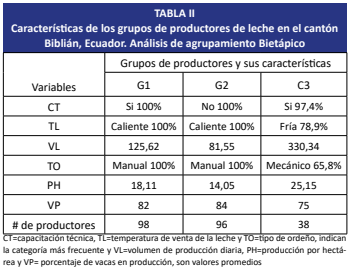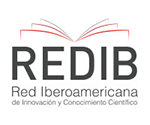Classification and characterization of bovine milk producers in the Biblian canton, Cañar province, Ecuador
Abstract
This study was conducted in the Biblián canton, a region of Ecuador with a dairy tradition, which contributes significantly to the national economy. A sample of 232 production units was used with the purpose of classify and characterize the producers of this region, according to a set of variables related to milk production, to carry it out, the two-stage automatic clustering method and a selection strategy among various cluster alternatives were applied, the variables considered were: years dedicated to dairy production, technical training, product sales temperature, daily sales volume, milking type, production per hectare, percentage of cows in production, most used labor, type of pasture, and producer education level. Three producer groups were identified, G1 and G2, of similar magnitude (42.2 and 41.4%), with G2 having the poorest characteristics. In G1 everyone has technical training while in G2 none do, G1 sells a higher average volume of milk, G1=125.62 L.day-1 compared to G2=81.65 L.day-1and also has a slight superiority in production per hectare, G1=18.11 L.ha-1 y
14.05 L.ha-1 for G2. They are similar in the proportion of cows in production, (84 and 82%) and equal in the temperature of sale of the product (Hot), in the type of milking (Manual), predominance of family labor and low educational level of the producer. G3, smaller in size (16.4%), showed a clear superiority whit a production of 330.34 L.day-1, it is the only group that has producers who use mechanical milking (65.8%) and sell day production cold (78.9%), almost all have technical training (97.4%), the hired worker prevails and a higher educational level for the producer. The results found reveal that in the Biblián canton the use of technology is limited and the main variables to intervene to effectively impact the milk production system are training, cooling and mechanized milking.
Downloads
References
Ministerio de Agricultura y Ganaderia (MAG). Cadena consultiva de la leche, terminales y servicios. 2018 [Recuperado 8 julio 2024]. Disponible en: https://www.agricultura.gob.ec
Palacios-Villacrés A, Guilcapi-Carrillo C, Toscano- Alcoser L, Vayas-Castillo G. Caracterizacion de sistemas pruductivos lecheros en la parroquia Juan Benigno Vela, Tungurahua, Ecuador. Pentaciencias. [Internet]. 2023; 5(4):147-157 doi: https://doi.org/p8hq DOI: https://doi.org/10.59169/pentaciencias.v5i4.656
Hernández-Morales P, Estrada-Flores JG, Avilés-Nova F, Yong-Angel G, López González F, Solís-Méndez AD, Castelán-Ortega OA. Tipificación de los sistemas campesinos de producción de leche del sur del estado de México. Uni. Cienc. [Internet]. 2013 [Citado 13 Ene 2025]; 29(1):19-31. Disponible en: https://goo.su/XzQpV
Quispe-Ccasa HA, Canto-Saenz FM, Ampuero G, Feijoo S, Huaman-Fuertes E. Caracterización del Sistema Productivo de Fincas Ganaderas de las provincias Tambopata y Tahuamanu, Madre de Dios, Perú. Rev. Científ. FCV-LUZ. [Internet]. 2022; 33:1-11. doi: https://doi.org/g6h7qd DOI: https://doi.org/10.52973/rcfcv-e33193
Ojeda-Carrasco JJ, Rueda-Quiroz LD, Hernandez-García PA, Espinoza-Ayala E. Characterization of the small- scale milk production system in the southeastern zone of Estado de Mexico. Agr. Soc. Desarro. [Internet]. 2020; 17(2):201-215. doi: https://doi.org/g578md DOI: https://doi.org/10.22231/asyd.v17i2.1342
Duran-Roja E, Calderón-Rangel A, Ramírez-Montoya J. Clasificación de empresas ganaderas doble propósito por calidad y canales de comercialización de la leche en el caribe colombiano. Rev. U.D.C.A. Actual. Divulg. Cient. [Internet]. 2020; 23(2):1-9. doi: https://doi.org/p8hr DOI: https://doi.org/10.31910/rudca.v23.n2.2020.1358
Juares-Barrientos JM, Díaz-Rivera P, Rodriguez-Miranda J, Martinez-Sánchez C, Hernández-Santos B, Ramírez- Rivera E, Torruco-Uco J, Herman-Lara E. Caracterización de la leche y clasificación de calidad mediante análisis cluster en sistemas de doble propósito. Rev. Mex. Cienc. Pecu. [Internet]. 2016; 7(4):525-537. doi: https://doi.org/p8hs DOI: https://doi.org/10.22319/rmcp.v7i4.4280
Chiu T, Fang D, Chen J, Wang Y, Jeris C. A Robust and Scalable Clustering Algorithm for Mixed Type Attributes in Large Database Environment. Data Min. Knowl. Discov. [Internet]. 2001; 263–268. New York, USA. doi: https://doi.org/d5c2z3 DOI: https://doi.org/10.1145/502512.502549
Instituto Nacional de Estadisticas y Censos (INEC). Encuesta de Superficie y Producción Agropecuaria
Continua. ESPAC. 2017 [Citado 22 Feb 2025]. 1-23. Disponible en: https://goo.su/M4vahXD
Instituto Nacional de Estadisticas y Censos (INEC). Población y Demografía. 2018 [Recuperado 8 de septiembre de 2024] Disponible en: https://www.ecuadorencifras.gob.ec .
Dalenius T, Hodges JL. Minimum Variance Stratification. J. Am. Stat. Assoc. [Internet]. 1959; 54(285):88-101. doi: https://doi.org/fvdxv5 DOI: https://doi.org/10.1080/01621459.1959.10501501
Scheaffer RL, Mendenhall III W, Lyman Ott R. Elementos de muestreo. 6th. ed. Madrid, España: International Thomson Editores; 2006.
IBM SPSS Statistics for Windows, Versión de prueba en español V 29.0; Mayo de 2024.
Norusis MJ. IBM SPSS Statistics Guides. 2005-2011 [Citado 10 Feb 2025]. Disponible en: https://goo.su/iLlBBJ
Kaufman L, Rousseeuw P. Finding Groups in Data. An Introduction to Cluster Analysis. 1st. ed. New Jersey, USA: John Wiley and Sons; 1990. DOI: https://doi.org/10.1002/9780470316801
Dunn OJ. Multiple Comparisons Among Means. J. Am. Stat. Assoc. [Internet]. 1961; 56(293):52–64. doi: https://doi.org/gd85vm DOI: https://doi.org/10.1080/01621459.1961.10482090
Glantz SA. Bioestadística. 6th. ed. México: MacGraw-Hill Interamericana; 2006.
















